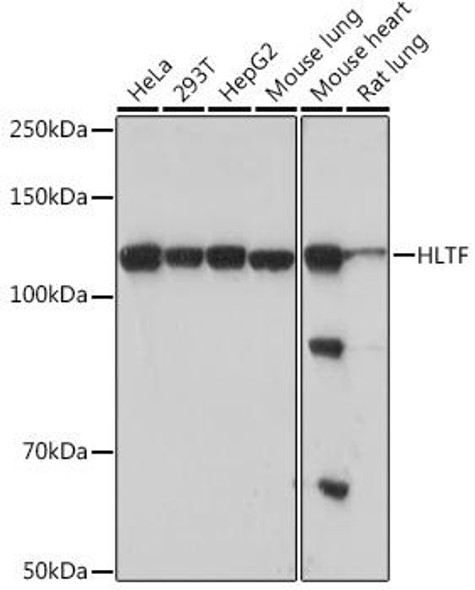Immunology Antibodies 3
Anti-LTF Antibody (CAB17931)
- SKU:
- CAB17931
- Product Type:
- Antibody
- Reactivity:
- Human
- Reactivity:
- Mouse
- Host Species:
- Rabbit
- Isotype:
- IgG
- Antibody Type:
- Polyclonal Antibody
- Research Area:
- Immunology
Description
| Antibody Name: | Anti-LTF Antibody |
| Antibody SKU: | CAB17931 |
| Antibody Size: | 20uL, 50uL, 100uL |
| Application: | WB IHC |
| Reactivity: | Human, Mouse |
| Host Species: | Rabbit |
| Immunogen: | A synthetic peptide of human LTF. |
| Application: | WB IHC |
| Recommended Dilution: | WB 1:500 - 1:2000 IHC 1:50 - 1:200 |
| Reactivity: | Human, Mouse |
| Positive Samples: |
| Immunogen: | A synthetic peptide of human LTF. |
| Purification Method: | Affinity purification |
| Storage Buffer: | Store at -20°C. Avoid freeze / thaw cycles. Buffer: PBS with 0.02% sodium azide, pH7.3. |
| Isotype: | IgG |
| Sequence: | Email for sequence |
| Gene ID: | 4057 |
| Uniprot: | P02788 |
| Cellular Location: | Cytoplasm, Cytoplasmic granule, Nucleus, Secreted |
| Calculated MW: | 73kDa/78kDa |
| Observed MW: | Refer to figures |
| Synonyms: | LTF, GIG12, HEL110, HLF2, LF |
| Background: | This gene is a member of the transferrin family of genes and its protein product is found in the secondary granules of neutrophils. The protein is a major iron-binding protein in milk and body secretions with an antimicrobial activity, making it an important component of the non-specific immune system. The protein demonstrates a broad spectrum of properties, including regulation of iron homeostasis, host defense against a broad range of microbial infections, anti-inflammatory activity, regulation of cellular growth and differentiation and protection against cancer development and metastasis. Antimicrobial, antiviral, antifungal and antiparasitic activity has been found for this protein and its peptides. Alternatively spliced transcript variants encoding different isoforms have been found for this gene. |
| UniProt Protein Function: | LTF: Transferrins are iron binding transport proteins which can bind two Fe(3+) ions in association with the binding of an anion, usually bicarbonate. Belongs to the transferrin family. 2 isoforms of the human protein are produced by alternative promoter. |
| UniProt Protein Details: | Protein type:Secreted; Protease; EC 3.4.21.-; Secreted, signal peptide Chromosomal Location of Human Ortholog: 3p21.31 Cellular Component: cell surface; cytoplasm; extracellular region; extracellular space; nucleus; protein complex; secretory granule; specific granule Molecular Function:heparin binding; iron ion binding; protein binding; protein serine/threonine kinase activator activity Biological Process: activation of NF-kappaB transcription factor; antibacterial humoral response; antifungal humoral response; cell redox homeostasis; cellular protein metabolic process; humoral immune response; innate immune response in mucosa; iron assimilation by chelation and transport; negative regulation of apoptosis; negative regulation of ATPase activity; negative regulation of lipopolysaccharide-mediated signaling pathway; negative regulation of viral genome replication; negative regulation of viral reproduction; positive regulation of I-kappaB kinase/NF-kappaB cascade; positive regulation of osteoblast differentiation; positive regulation of osteoblast proliferation; positive regulation of toll-like receptor 4 signaling pathway; regulation of cytokine production; regulation of tumor necrosis factor production; retinal homeostasis |
| NCBI Summary: | This gene is a member of the transferrin family of genes and its protein product is found in the secondary granules of neutrophils. The protein is a major iron-binding protein in milk and body secretions with an antimicrobial activity, making it an important component of the non-specific immune system. The protein demonstrates a broad spectrum of properties, including regulation of iron homeostasis, host defense against a broad range of microbial infections, anti-inflammatory activity, regulation of cellular growth and differentiation and protection against cancer development and metastasis. Antimicrobial, antiviral, antifungal and antiparasitic activity has been found for this protein and its peptides. Alternatively spliced transcript variants encoding different isoforms have been found for this gene. [provided by RefSeq, Sep 2014] |
| UniProt Code: | P02788 |
| NCBI GenInfo Identifier: | 85700158 |
| NCBI Gene ID: | 4057 |
| NCBI Accession: | P02788.6 |
| UniProt Secondary Accession: | P02788,O00756, Q16780, Q16785, Q16786, Q16789, Q5DSM0 Q8IU92, A8K9U8, B2MV13, B7Z4X2, E7EQH5, |
| UniProt Related Accession: | P02788 |
| Molecular Weight: | 73,161 Da |
| NCBI Full Name: | Lactotransferrin |
| NCBI Synonym Full Names: | lactotransferrin |
| NCBI Official Symbol: | LTF |
| NCBI Official Synonym Symbols: | LF; HLF2; GIG12; HEL110 |
| NCBI Protein Information: | lactotransferrin |
| UniProt Protein Name: | Lactotransferrin |
| UniProt Synonym Protein Names: | Growth-inhibiting protein 12; Talalactoferrin |
| Protein Family: | Lactotransferrin |
| UniProt Gene Name: | LTF |
| UniProt Entry Name: | TRFL_HUMAN |






